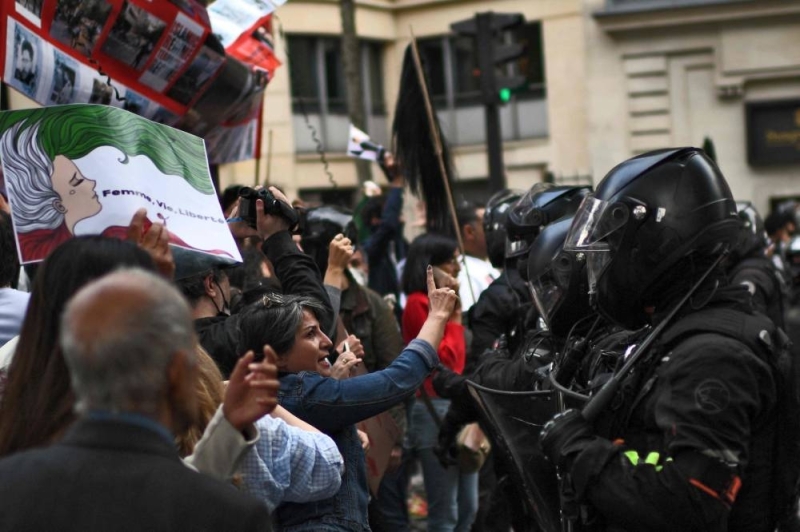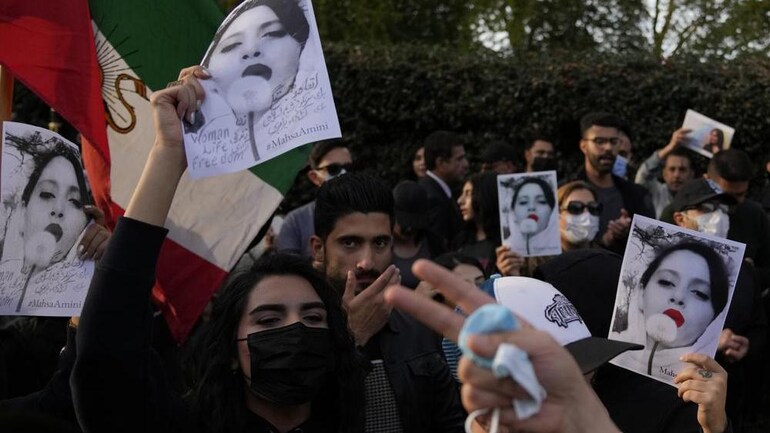British Columbia
Thousands gather in downtown Vancouver to show support for Iranian protests
It's the 2nd protest this week in Metro Vancouver following death of Mahsa Amini, 22
Thousands of people gathered on the steps of the Vancouver Art Gallery on Sunday then marched through downtown calling on Iran to end laws requiring women to wear hijabs in public as well as to abolish the country's use of capital punishment.
It's the second protest this week in Metro Vancouver following the death of Mahsa Amini, 22.
The Iranian woman died last week after she was arrested by Iran's morality police for "unsuitable attire" after she allegedly wore a hijab improperly.
Her death has reignited anger over restrictions on personal freedoms in Iran, including the strict dress codes for women and an economy reeling from government sanctions.
Protests over Amini's death have spread across at least 46 cities, towns and villages in Iran. There has also been condemnation from Western countries and the United Nations, as well as protests in solidarity abroad.
On Sunday there were protests in London where violence broke out. In Canada, a protest similar to Vancouver's was held in Ottawa.
Tammy Sadeghi was one of the organizers of the rally in Vancouver on Sunday.
"We're here to support the Iranian movement in Iran, especially since women came onto the street because they have been fed up with this regime the last 42 years," Sadeghi said.
"They've been fighting day and night to push back the Islamic regime."
Many at the rally said they want an end to laws that require women to wear hijabs. They also want an end to capital punishment in Iran and the release of political prisoners — all examples of the regime's brutality.
Iranian police have denied mistreating Amini and claim she died of a heart attack. The country's authorities say they are investigating.
Protests in Iran have resulted in the deaths of both protesters and police and the arrests of demonstrators.
Honieh Barzegari said she attended the rally in Vancouver to speak out for human rights in Iran. She said she was impressed with how diverse the crowd was.
"We need to stay united, not just Iranian people. We want the world to stand with us. Hold our hands, tap on our shoulders and be our voices," she said.
'Human lives matter, Iranian lives matter. Iranian women's lives matter. We all matter."
With files from Janella Hamilton, Jon Azpiri, Thomson Reuters and the Associated Press
Protesters march through downtown Ottawa, burn headscarf in demonstration against Iran
Crowds pledged solidarity with Iranians after woman dies in custody of morality police
With the death of a young Iranian woman in police custody sparking demonstrations around the world, hundreds of people also took to the streets of Ottawa Sunday to protest against the Iranian government.
The 22-year-old woman died last week while in custody of Iran's morality police. Mahsa Amini was arrested for allegedly wearing a hijab improperly, and while police said she died of a heart attack and was not mistreated, her family has cast doubt on that account.
"This could have happened to [any] one of us," said Taraneh, a protester who lived in Iran for about 30 years. CBC is withholding her last name due to her safety concerns.
Taraneh said she and her sister were once arrested by the morality police while in Iran and held for five or six hours. She said she's frustrated that Iranian women are forced to comply with the strict hijab requirements.
"The women in Iran are not free at all," she said. "We are tired of this system."
Movement larger than just opposition to hijab
The protesters marched past Parliament Hill on Wellington Street, down Metcalfe Street and onto Queen Street, where they gathered to chant and burn a scarf in protest.
Police estimated about 1,000 people took part.
"It's not just a matter of hijab anymore. It's not a matter of the morality police forces anymore," said organizer Rosa Kheirandish, who was born in Iran and moved to Canada in 2001.
"They just want the mandatory Islamic Republic to go."
Kheirandish said she helped organize the protest so that other Iranians could claw back their freedom from the oppressive government — starting with freedom of religion.
"[They want] that same kind of freedom that we have here in Canada," said Kheirandish. "I mean, thank God we have it here."
She said she also hopes the protest raises awareness of what Iranians are facing.
Protestors concerned about internet access
Iranians have experienced widespread internet disruptions amid days of mass protests against the government, including a loss of access to Instagram and WhatsApp, two of the last Western social media platforms available in the country.
Kheirandish fears that the disconnection will precede government violence.
In November 2019, Iran imposed a five-day nationwide internet shutdown to stifle protests against fuel price hikes. By the time access was restored, Amnesty International said over 100 demonstrators had been killed by security forces — a figure rejected as "speculative" by the government.
Another protester, Lora Solaimani, said she was concerned internet outages may also impede Iranians' ability to call to the international community for help.
"They've cut the internet so that we can't actually see what's going on," said Solaimani. "I think that needs international attention."
Oppressive government a 'risk' to world
Protestor Rahil Golipoor, a risk analyst for the federal government, said the oppression of human rights happening in Iran could have a harmful impact worldwide.
"The Islamic Republic of Iran is a risk for the world," Golipoor said, adding that the actions by the country's morality police could influence other governments. "They are a virus starting in Iran, but they don't stay in Iran."
Golipoor said she is demonstrating not just against Iran, but to send a global message against all religious and gender-based discrimination.
"We stand for the future of the world," said Golipoor. "We don't stay silent for any dictator [or] religion."
With files from Darren Major, The Associated Press and Thomson Reuters














